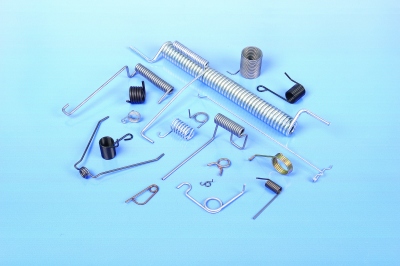E-spring
Vehicle suspension has always relied on conflicting requirements such as; passenger comfort, road holding and load carrying, to be in balance. This intricate balance has long been a contentious issue for engineers. Suspension springs are designed to absorb shock from the road by compression and extension when bumps are encountered.
The spring rate has a large impact on the performance of a vehicle in relation to these factors. A low spring rate can increase passenger comfort, but at the detriment of the other factors and a high spring rate with a heavy load causes excessive bumps. Variation in spring rate, therefore, would be a great aid to vehicle suspension.
Such a concept has been created in the by Cambridge postgraduate researcher Salah Elmoselhy’s concept of the E-spring.
The concept behind the E-shaped spring is that it can offer the variation needed in spring rate to give the best experience for both passenger comfort, road holding and load bearing. The unique shape means that some sections flex easily under light loads whilst another can increase the stiffness as the load increases.
Such a shape avoids undue stress and can contribute to the longevity of the spring and thus improve vehicle performance. Further improvements to suspension can be made the more E-springs that are used.
There are many benefits that the new E-spring can bring to car suspension. Weight reduction of up to 80% can lead to a long-term reduction of fuel consumption, making vehicles more efficient. It also means that there is a much-reduced space requirement, leaving more room for safety equipment and other such necessities.
The compact space of the E-spring means that variable loads can be moved and passenger comfort never has to be sacrificed. This, removes the need for hydraulic dampeners and improves the overall fatigue performance of vehicles.
The scalability of this spring also means that it can be used in items as small as semiconductor chips for smarter technology.
[edit] Find out more
[edit] Related articles on Designing Buildings Wiki
Featured articles and news
RTPI leader to become new CIOB Chief Executive Officer
Dr Victoria Hills MRTPI, FICE to take over after Caroline Gumble’s departure.
Social and affordable housing, a long term plan for delivery
The “Delivering a Decade of Renewal for Social and Affordable Housing” strategy sets out future path.
A change to adoptive architecture
Effects of global weather warming on architectural detailing, material choice and human interaction.
The proposed publicly owned and backed subsidiary of Homes England, to facilitate new homes.
How big is the problem and what can we do to mitigate the effects?
Overheating guidance and tools for building designers
A number of cool guides to help with the heat.
The UK's Modern Industrial Strategy: A 10 year plan
Previous consultation criticism, current key elements and general support with some persisting reservations.
Building Safety Regulator reforms
New roles, new staff and a new fast track service pave the way for a single construction regulator.
Architectural Technologist CPDs and Communications
CIAT CPD… and how you can do it!
Cooling centres and cool spaces
Managing extreme heat in cities by directing the public to places for heat stress relief and water sources.
Winter gardens: A brief history and warm variations
Extending the season with glass in different forms and terms.
Restoring Great Yarmouth's Winter Gardens
Transforming one of the least sustainable constructions imaginable.
Construction Skills Mission Board launch sector drive
Newly formed government and industry collaboration set strategy for recruiting an additional 100,000 construction workers a year.
New Architects Code comes into effect in September 2025
ARB Architects Code of Conduct and Practice available with ongoing consultation regarding guidance.
Welsh Skills Body (Medr) launches ambitious plan
The new skills body brings together funding and regulation of tertiary education and research for the devolved nation.
Paul Gandy FCIOB announced as next CIOB President
Former Tilbury Douglas CEO takes helm.
UK Infrastructure: A 10 Year Strategy. In brief with reactions
With the National Infrastructure and Service Transformation Authority (NISTA).























